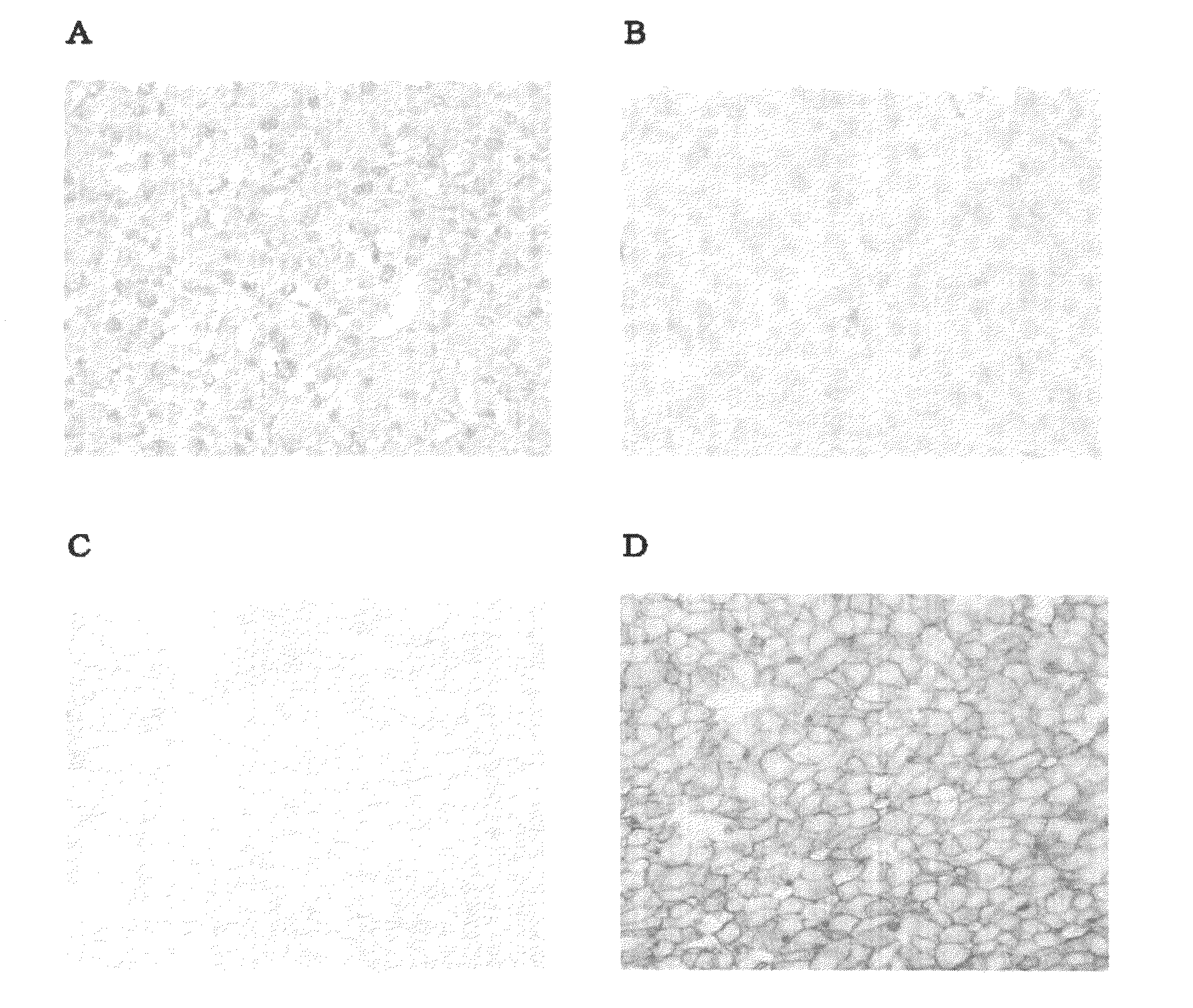Method for detection of liver cancer cell using Anti-glypican-3 antibody
a technology of antiglypican and liver cancer, which is applied in the field of in vitro immunoassay methods for detecting the presence of liver cancer cells, can solve the problems of false positive or false negative, misinterpretation of staining, and inability to achieve ideal fixatives, and achieve the effect of accurate detection of the expression pattern of glypican 3
- Summary
- Abstract
- Description
- Claims
- Application Information
AI Technical Summary
Benefits of technology
Problems solved by technology
Method used
Image
Examples
example 1
Immunostaining of Glypican 3 Using Mouse Models in which Human Liver Cancer Cell Strain Expressing Glypican 3 was Subcutaneously Transplanted into the Abdominal Region
(1) Cell Strain
[0128]The liver cancer cell strains used were HuH-7 cells (Health Science Research Resources Bank, HSRRB) and HepG2 cells (ATCC). HuH-7 was maintained and subcultured in Dulbecco's Modified Eagle's Medium (SIGMA-ALDRICH CO.) containing 10% FBS (BIONET). HepG2 was maintained and subcultured in Minimum Essential Medium Eagle medium (SIGMA-ALDRICH CO.) containing 10% FBS, 1 mmol / L MEM Sodium Pyruvate (Invitrogen Corp.), and 1 mmol / L MEM Non-Essential Amino Acid (Invitrogen Corp.).
(2) Measurement of GPC3 Expression Level
(2-1) Measurement Method
[0129]The GPC3 expression levels of the HuH-7 and HepG2 cells were measured using a mouse anti-human GPC3 monoclonal antibody (clone name: GC33, described in WO2006 / 006693) and QIFI-Kit (DakoCytomation). The measurement method was conducted according to a method descri...
example 2
Antigen Retrieval Effect of Protease in GPC3 Immunostaining Using Human Hepatocellular Carcinoma Tissue Preparation
(1) Immunohistochemical Staining of Human Hepatocellular Carcinoma Samples
(1-1) Methods for Preparing and Staining Preparations
[0183]Human hepatocellular carcinoma samples were dipped in 10% neutral buffered formalin for the predetermined time or longer for fixation. Next, paraffin-embedded block preparations were prepared according to a standard method. The block preparations were cut into thin slices, and these tissue sections were used in immunohistochemical staining. The immunohistochemical staining was carried out by the same procedures as in Example 1.
(1-2) Method for Evaluating Staining Results
[0184]On the basis of the description of the paragraph (6-2) of Example 1, stainability in the immunostaining using the mouse anti-human GPC3 antibody was evaluated according to three parameters (rate of positive cells: PR, staining intensity: SI, and cell membrane staining...
example 3
Drug Efficacy of Anti-GPC3 Antibody on GPC3-Expressing Human Liver Cancer Cell Strain-Transplanted Mouse Models
(1) Cell Strain
[0209]Cells used in transplantation were HuH-7 cells and HepG2 cells. The HuH-7 cells were maintained and subcultured in Dulbecco's Modified Eagle's Medium (SIGMA-ALDRICH CO.) containing 10% FBS (BIONET). The HepG2 cells were maintained and subcultured in Minimum Essential Medium Eagle medium (SIGMA-ALDRICH CO.) containing 10% FBS, 1 mmol / l MEM Sodium Pyruvate (Invitrogen Corp.), and 1 mmol / l MEM Non-Essential Amino Acid (Invitrogen Corp.).
(2) Preparation of Human Liver Cancer Cell Strain-Transplanted Mouse Models
[0210]The cells of these strains were separately adjusted to 5×107 cells per ml with a solution containing equal amounts of the medium for maintenance and subculture described above and Matrigel Matrix (BD Biosciences). One day before cell transplantation, 100 μl of an anti-asialo GM1 antibody (Wako Pure Chemical Industries, Ltd.; 1 vial was dissolv...
PUM
| Property | Measurement | Unit |
|---|---|---|
| Volume | aaaaa | aaaaa |
| Fraction | aaaaa | aaaaa |
| Fraction | aaaaa | aaaaa |
Abstract
Description
Claims
Application Information
 Login to View More
Login to View More - R&D
- Intellectual Property
- Life Sciences
- Materials
- Tech Scout
- Unparalleled Data Quality
- Higher Quality Content
- 60% Fewer Hallucinations
Browse by: Latest US Patents, China's latest patents, Technical Efficacy Thesaurus, Application Domain, Technology Topic, Popular Technical Reports.
© 2025 PatSnap. All rights reserved.Legal|Privacy policy|Modern Slavery Act Transparency Statement|Sitemap|About US| Contact US: help@patsnap.com



